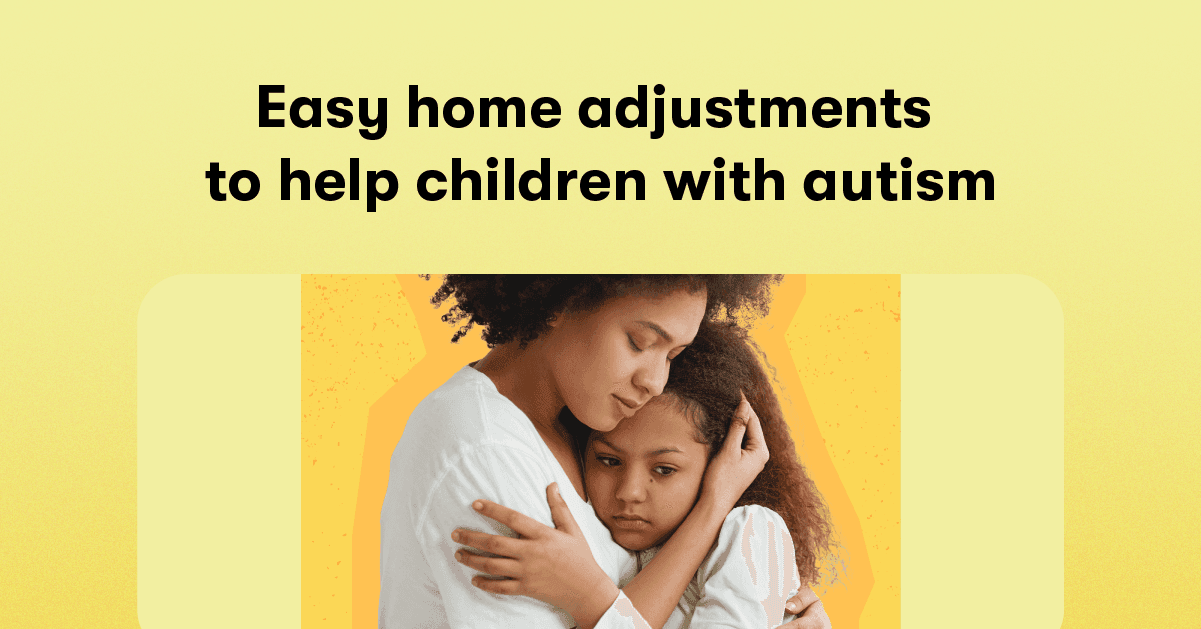Easy home adjustments to help children with autism

By Alexandra Boeving Allen, PhD, Sep 6, 2024
Kids with autism tend to either over-respond or under-respond to certain things that they see, hear, taste, touch, or smell. These big responses (hypersensitivity) or lack of response (hyposensitivity) can impact how kids feel and act.
As you become more aware of your child’s sensory needs, you can look for ways to help them feel more comfortable at home. A few small adjustments may make a big difference. We have some suggestions to get you started.
Sight
Hypersensitivity: Help your child feel more comfortable by using different colored lighting or dimmable lights. You can also try closing blinds or using lamps instead of overhead lights.
Hyposensitivity: For children who under-respond to visual stimuli, toys with bright or flashing lights/colors and light-up trinkets may be helpful in moments of frustration.
Sound
Hypersensitivity: When your child needs a quiet environment, noise-canceling headphones, ear plugs, or a “calming corner” can help. You can also try preparing your child for a noise; for example, ”Here comes the vacuum cleaner! Let’s cover your ears.”
Hyposensitivity: If your child craves more sound, you and your family members can try speaking more loudly or in an exaggerated way. You could play music or encourage your child to use items around the house, like kitchen pots, to make their own.
Touch
Hypersensitivity: Some textures that may not bother you can be truly distressing for kids with autism. It can help to remove clothing tags and consider fabrics they like for clothes or bedding. Introducing sensory boxes that contain items like beans, rice, or sand may help your child get used to new textures.
Hyposensitivity: Consider stronger versions of touch like squeezing or massaging, and letting your child play with items they can manipulate and smear, like Play-Doh or homemade slime.
Smell
Hypersensitivity: If your child gets overwhelmed by smells, use unscented soap, shampoo, laundry detergent, and other household products.
Hyposensitivity: Kids who have a low response to smells often enjoy scented household items and art supplies. They may also love spending time outdoors.
Taste
At mealtime, be mindful of foods that your child is particularly sensitive to. Make sure everyone involved with their care understands your child’s preferences. Sensitivities around food often require professional support to make sure your child is getting proper nutrition. (Your Brightline care team can help!)
Other tips to help your child at home
As you make changes to help your child feel more comfortable, don’t forget to:
Declutter: Cleaning up, simplifying, and organizing can help limit stimuli and distractions for your child. Putting things out of reach also provides opportunities for them to engage with you and practice their language skills!
Take your time: Although you may be excited to make changes, don’t adjust everything at once. Too many changes can overwhelm your child.
Be consistent: Make sure everyone in your home understands the adjustments and can support them. If something works well at home, let your child’s teacher (or others they spend time with) know. They may be able to make similar changes in your child’s classroom or at the babysitter’s house, for example.
Expect some growing pains: Transitions — even to something meant to be helpful — can be pretty bumpy. Your child may feel confused or frustrated at first by the changes you make. Give them time to adjust.
Try to be flexible: Sensory processing preferences can change over time. Something that helps your child today may need to change again in the future as your child develops.
When questions come up, reach out to your care team. We can help you navigate, adjust, and plan. Brightline’s Parent Coaching for ASD can also help you guide your child through these changes.